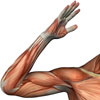Neurological Rehabilitation and Movement Disorders
- Spasticity
- Dystonia
- Botulinum toxin injections for neurological disorders
- Multiple sclerosis
- Parkinson’s disease
- Huntington’s disease
Spasticity
 | Spasticity is a form of muscle overactivity that significantly impedes physical movements or motor functioning. It is thought to be related to hyperexcitable spinal reflexes and is characterised by muscle rigidity, muscle dystonia, associated reaction, and muscle co-contraction. |
For more information, see Spasticity.
Post stroke upper limb spasticity
 | It is estimated that up to 60,000 Australians had a stroke in 2009, a figure that will continue to rise as the population ages. For those who survive a first-ever stroke, the damage caused to the motor (movement) pathway in the brain as a consequence of the event can lead to spasticity. |
For more information, see Post Stroke Upper Limb Spasticity.
Dystonia
 | Dystonia is a movement disorder characterised by involuntary, repetitive, sustained and directional movements and postures. It is a unique neurological condition, as it can be either an inherited disorder or acquired as a result of conditions such as stroke. |
For more information, see Dystonia.
Cervical dystonia
 | Cervical dystonia (CD) is the most common dystonia limited to one part of the body, and is specifically localised in the neck muscles. It is characterised by abnormal head posture, involuntary muscle contractions of the cervical spine, head tremor, sustained neck spasms and craniocervical pain. |
For more information, see Cervical Dystonia.
Spasmodic dysphonia (laryngeal dystonia)
 | Spasmodic dysphonia (SD) is a rare form of dystonia that affects the laryngeal muscles (vocal cords). It is also known as laryngeal dystonia. SD is characterised by poor vocal motor control during speech, and people with SD exert significant effort and strain to speak. There are two types of SD which display markedly different vocal symptoms. |
For more information, see Spasmodic Dysphonia (Laryngeal Dystonia).
Botulinum toxin injections for neurological disorders
 | Botulinum toxin is a neurotoxin that is produced by the bacterium responsible for botulism, clostridium botulinum. The neurotoxin works by weakening the muscles and stopping them from contracting very well, which can lead to paralysis. |
For more information, see Botulinum Toxin Injections for Neurological Disorders.
Multiple sclerosis
 | Multiple sclerosis is a disease of the brain and spinal cord thought to be caused by an autoimmune reaction. It is characterised by loss of the myelin sheath covering nerves of the central nervous system. This reduces the nerve’s conduction speed and causes various neurological symptoms such as loss of vision, motor weakness, abnormal sensations and pain. |
For more information, see Multiple Sclerosis.
Parkinson’s disease
 | Parkinson’s disease is a neurodegenerative disorder that affects approximately two percent of the population over 65 years. It is caused by a deficiency of a chemical called dopamine in certain areas of the brain. Patients with Parkinson’s disease have three classical signs: resting tremor, slowness of movement and rigidity. |
For more information, see Parkinson’s Disease.
Huntington’s disease
 | Huntington’s disease is a progressive disease that results in the slow loss of affected brain cells. It is an inherited condition that begins in adulthood. At present, typical Huntington’s disease is a lethal condition. Huntington’s disease is characterised by involuntary movements, dementia and psychological disturbances that worsen as the disease progresses. |
For more information, see Huntington’s Disease.
Dates
Tags
Created by:

 Login
Login














